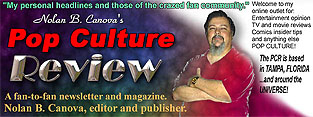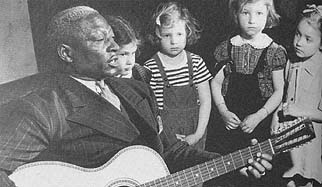

 |  |
|
Frontpage La Floridiana Movie Review Mike's Rant Matt's Rail Viddywell PCR Archives 2002 2001 2000 Crazed Fanboy homepage PCR 2002 Home |

| Part 9: |
 |
 |
|
In the great tradition of Mark Twain or the legends of Johnny Appleseed tales tell of a bluesman of extraordinary prowess with the 12-string guitar, a larger-than-life character who traveled with the great Blind Lemon Jefferson but whose repertoire was much wider than his blues contemporaries, a man who loved to play for children but was a convicted murderer. A talent who while wasting away in jail was seemingly plucked by the hand of fate and gained fame in his final years. The only bluesman to play Europe. But this bluesman was no fabrication or tale, he was real. He was Lead Belly.
To call Lead Belly a mere bluesman would be doing him an injustice. He was a folk hero in every way imaginable and here is his tale. Lead Belly was born Huddie Ledbetter near Mooringsport in Lousiana in 1889. This birth date marks him as a first-generation bluesman. But Huddie Ledbetter was much more than a bluesman. He played everything from blues to children's songs, field hollers, folk ballads, spirituals,....the list goes on. He was not only potent on the guitar but could also play piano and even accordian. When Huddie was 5 years old the Ledbetter family moved to Leigh, Texas. There, his uncle gave him an accordian as a gift and from then on little Huddie knew what he was destined to become: a musician. So it was at the age of 16 that Huddie left home to pursue his dream. He slung a guitar over his shoulder and took off down the road of life. He went to many country parties or "sukey-jumps" and watched how his favorite bluesmen played. He traveled far and wide and picked up many songs from the different regions he visted. Huddie had a brush with the law early in his life when he shot at a man who was bothering Huddie's girlfriend. Huddie was charged a fine for carrying a fire arm. This would not be the last time Huddie would face the justice of the court.
It was on the road that Huddie met Blind Lemon Jefferson. Jefferson and Huddie would ramble around all of America like the two vagabond artists they were and their presence was felt by all who heard them play. Jefferson went on to become a legend of Texas blues and Huddie might have shared this status had he not broke the law once again. Huddie was arrested on petty charges and eventually escaped from prison and made his way back home to his father. Huddie's father hid him and Huddie took up the alias "Walter Boyd". In 1917, Huddie was finally caught and arrested after shooting Will Straford and fatally wounding him. Huddie received 30 years of hard labor in the Shaw State Prison farm. Huddie was allowed to keep his guitar and play it for the inmates. He eventually became popular with the guards too. Seeing this, Huddie saw a way to get out of the pen. When Governor Pat Neff visited the prison in 1924 Huddie sang him a song titled just for him "Gov. Pat Neff". Have mercy on my great long time I don't see to save my soul If I don't get a pardon, try me on a parole If I had you, Governor Neff, like you got me I'd wake up in the mornin' and I'd set you free Neff was so impressed that he pardoned Huddie. Huddie returned to his birthplace of Mooringsport and got a job truck driving but he also returned to his old life style of bars, womanizing, gambling, and drinking. Huddie earned a huge amount of respect in his community for his musical abilities and his amazing feat of singing his way out of prison. But Huddie was still hot with envy, Blind Lemon was now a famous recording star and he wasn't. Huddie eventually quit his job and tried to earn his living by playing his music. In 1930 he was convicted with assualt with intent to murder and was arrested and holed up in the notorious Louisiana State Penitentiary in Angola. It was here that he got the nickname that would stick with him for life: Lead Belly. Lead Belly sat defeated never to gain fame as his buddy Blind Lemon did. He was done for good.
In 1941 Lead Belly had a falling out with Lomax. Lead Belly was sick and tired of Lomax presenting him as a race singer and dressing him up in his prison stripes at gigs. Lead Belly felt like a caged animal singing for the white folks amusement. Lomax claimed Lead Belly had become arrogant and ungrateful and that he was starting to believe his own good press. After a heated argument Lead Belly purportedly pulled a knife on Lomax. From then on Lomax wanted nothing to do with him. If Lomax presented Lead Belly as a racial stereotype then it can be said that Moses Asch presented to the public Lead Belly the artist. Asch, an independent producer in association with Smithsonian, recorded Lead Belly as he was. Whatever Lead Belly wanted to record he was free to do so. Out of the Asch sessions came the most beloved versions of Lead Belly's tunes "In the Pines"(Where did you sleep last night?),"On a Monday", "Blind Lemon", "Grey Goose", "John Henry", and "Irene".
Lead Belly embarked on a tour of Europe in 1949 but while on the tour he fell ill. The doctor diagnosed him with Lou Gehrig's disease and he died on December 6, 1949. He was the first black folk performer to tour Europe and fame was only six months away when he died. Because though he never saw it, six months after his death his signature tune "(Goodnight) Irene" as recorded by the Weavers became a hit, selling over 2 million copies and has since then become a folk standard.
Huddie Ledbetter saw himself as a man in a cage performing for the white folks but at least due to his good friends Moses Asch and Woody Guthrie he saw that to the people that cared he was much much more. His songs still live on today as they inspired songs by major rock acts like Nirvana and Pearl Jam. Lead Belly was a encylopedia of music, a great guitarist, a superb singer with a great booming voice, and a larger than life personality. Even though the last place he played was Europe he was, without a doubt, ours. Lead Belly was America's National Treasure. Me and my wife settled down, Now me and my wife we are parted, I think I'll go out on the town. Sometimes I live in the country, Irene good night, Irene good night, -(Goodnight) Irene by Lead Belly  |
"The Enlightenment" is ©2002 by Terence Nuzum. Webpage design and all graphics herein (except where otherwise noted) are creations of Nolan B. Canova. All contents of Nolan's Pop Culture Review are ©2002 by Nolan B. Canova.